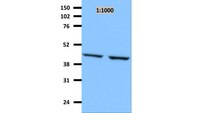HIV-1 capsids bind and exploit the kinesin-1 adaptor FEZ1 for inward movement to the nucleus.
Malikov, V; da Silva, ES; Jovasevic, V; Bennett, G; de Souza Aranha Vieira, DA; Schulte, B; Diaz-Griffero, F; Walsh, D; Naghavi, MH
Nat Commun
6
6660
2015
Show Abstract
Intracellular transport of cargos, including many viruses, involves directed movement on microtubules mediated by motor proteins. Although a number of viruses bind motors of opposing directionality, how they associate with and control these motors to accomplish directed movement remains poorly understood. Here we show that human immunodeficiency virus type 1 (HIV-1) associates with the kinesin-1 adaptor protein, Fasiculation and Elongation Factor zeta 1 (FEZ1). RNAi-mediated FEZ1 depletion blocks early infection, with virus particles exhibiting bi-directional motility but no net movement to the nucleus. Furthermore, both dynein and kinesin-1 motors are required for HIV-1 trafficking to the nucleus. Finally, the ability of exogenously expressed FEZ1 to promote early HIV-1 infection requires binding to kinesin-1. Our findings demonstrate that opposing motors both contribute to early HIV-1 movement and identify the kinesin-1 adaptor, FEZ1 as a capsid-associated host regulator of this process usurped by HIV-1 to accomplish net inward movement towards the nucleus. | 25818806
 |
Generation of VSV pseudotypes using recombinant ΔG-VSV for studies on virus entry, identification of entry inhibitors, and immune responses to vaccines.
Whitt, MA
J Virol Methods
169
365-74
2010
Show Abstract
Vesicular stomatitis virus (VSV) is a prototypic enveloped animal virus that has been used extensively to study virus entry, replication and assembly due to its broad host range and robust replication properties in a wide variety of mammalian and insect cells. Studies on VSV assembly led to the creation of a recombinant VSV in which the glycoprotein (G) gene was deleted. This recombinant (rVSV-ΔG) has been used to produce VSV pseudotypes containing the envelope glycoproteins of heterologous viruses, including viruses that require high-level biocontainment; however, because the infectivity of rVSV-ΔG pseudotypes is restricted to a single round of replication the analysis can be performed using biosafety level 2 (BSL-2) containment. As such, rVSV-ΔG pseudotypes have facilitated the analysis of virus entry for numerous viral pathogens without the need for specialized containment facilities. The pseudotypes also provide a robust platform to screen libraries for entry inhibitors and to evaluate the neutralizing antibody responses following vaccination. This manuscript describes methods to produce and titer rVSV-ΔG pseudotypes. Procedures to generate rVSV-ΔG stocks and to quantify virus infectivity are also described. These protocols should allow any laboratory knowledgeable in general virological and cell culture techniques to produce successfully replication-restricted rVSV-ΔG pseudotypes for subsequent analysis. | 20709108
 |
Cells that express all five proteins of vesicular stomatitis virus from cloned cDNAs support replication, assembly, and budding of defective interfering particles.
Pattnaik, AK; Wertz, GW
Proc Natl Acad Sci U S A
88
1379-83
1991
Show Abstract
An alternative approach to structure-function analysis of vesicular stomatitis virus (VSV) gene products and their interactions with one another during each phase of the viral life cycle is described. We showed previously by using the vaccinia virus-T7 RNA polymerase expression system that when cells expressing the nucleocapsid protein (N), the phosphoprotein (NS), and the large polymerase protein (L) of VSV were superinfected with defective interfering (DI) particles, rapid and efficient replication and amplification of (DI) particle RNA occurred. Here, we demonstrate that all five VSV proteins can be expressed simultaneously when cells are contransfected with plasmids containing the matrix protein (M) gene and the glycoprotein (G) gene of VSV in addition to plasmids containing the genes for the N, NS, and L proteins. When cells coexpressing all five VSV proteins were superinfected with DI particles, which because of their defectiveness are unable to express any viral proteins or to replicate, DI particle replication, assembly, and budding were observed and infectious DI particles were released into the culture fluids. Omission of either the M or G protein expression resulted in no DI particle budding. The vector-supported DI particles were similar in size and morphology to the authentic DI particles generated from cells coinfected with DI particles and helper VSV and their infectivity could be blocked by anti-VSV or anti-G antiserum. The successful replication, assembly, and budding of DI particles from cells expressing all five VSV proteins from cloned cDNAs provide a powerful approach for detailed structure-function analysis of the VSV gene products in each step of the replicative cycle of the virus. | 1847519
 |















